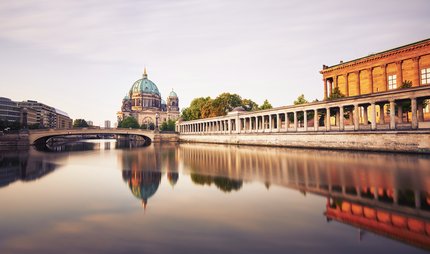
Pergamon Museum
Currently closed - reopening in 2027
The Pergamon Museum is currently closed for extensive renovation work. In 2027, the Pergamon Hall with the Great Frieze, the Collection of Classical Antiquities and the Museum of Islamic Art with the Mshatta façade will be on display again.
Even now you can experience the treasures from the Pergamonmuseum:
The Pergamonmuseum is completely closed until 2027, but the exhibition "Pergamonmuseum. The Panorama" exhibition with the 360-degree panorama by Yadegar Asisi and antique originals from Pergamon brings the Pergamon Altar to life in its original form and in its urban context on the Acropolis. It is located opposite the Museum Island.
Which world-famous buildings from antiquity are on display in the Pergamon Museum?
The Pergamon Museum, which is now closed, harbours great cultural treasures:

For example, the monumental Pergamon Altar from Roman antiquity (180/160 BC) with its famous Great Frieze. You can admire it again in 2027.


Or the mshatta façade from a desert residence of Umayyad caliphs in present-day Jordan, rich in filigree stucco walls. It belongs to the Museum of Islamic Art, which will reopen in the Pergamon Museum in 2027.


The Pergamon Museum also houses the Processional Way of Babylon with the shimmering turquoise-coloured Ishtar Gate, which were created more than 2,600 years ago. They will be on display again in the 2030s.

Spectacular: the imposing market gate of Miletus, a magnificent example of Roman imperial architecture from what is now western Turkey, which has two storeys with richly decorated columns, beams and pediments. This large-scale architecture will not be on display again until the 2030s.
Overview: What can be seen again and when?
- Pergamon Hall with the Pergamon Altar: 2027
- Collection of Classical Antiquities with large sculptures and Greek and Roman columns: 2027
- Museum of Islamic Art with the Mshatta façade: 2027
- Ishtar Gate with the Processional Way of Babylon: 2030s
- Market Gate of Miletus: 2030s
History of the Pergamon Museum: Babylon and the Near East
After the famous merchant and archaeologist Heinrich Schliemann uncovers Troy, excavation fever breaks out in the 19th century. German researchers travelled to Pergamon, Miletus, Babylon, Uruk, Assur and Egypt. The Ottoman Empire granted generous conditions for sharing finds, which is why important architectural monuments, sculptures and small artefacts were exported to Berlin. Their finds are soon exhibited on Berlin's Museum Island, in the predecessor building to the Pergamon Museum. But after a short time, the space was no longer sufficient. Between 1910 and 1930, the Pergamon Museum was built according to plans by architect Alfred Messel. It soon became one of Berlin's main attractions. In addition to the imposing Pergamon Altar - the pinnacle of Hellenistic art - the 17 metre high Market Gate of Miletus and the magnificent Ishtar Gate form the core of the exhibition.
Our recommendations: Attractions in the neighbourhood
Museum Island in Berlin, a UNESCO World Heritage Site and home to spectacular art treasures, is celebrating its anniversary: the history of this unique ensemble of buildings in the heart of Berlin began 200 years ago.
For five years, five major museums will be hosting fascinating special exhibitions:
The highlight of the Neues Museum is the famous bust of Nefertiti. The museum also presents a true-to-original Egyptian court, mummies and valuable papyrus scrolls. Right next door at the Lustgarten, you are greeted by the mighty rotunda dome as soon as you enter the Altes Museum. Behind the columns and sculptures, you reach the collection of Roman and Greek sculpture. The Alte Nationalgalerie, on the other hand, is for lovers of German painting. Classics such as Caspar David Friedrich and the landscape painter Carl Blechen take centre stage. You can marvel at the famous group of princesses by the sculptor of the Quadriga on the Brandenburg Gate, Friedrich Wilhelm von Schadow. In the northern part of the Museum Island is the Bode Museum with its striking copper dome. Inside the imposing building, the sculpture collection, the Coin Cabinet and the Museum of Byzantine Art invite you to take a fascinating tour.



